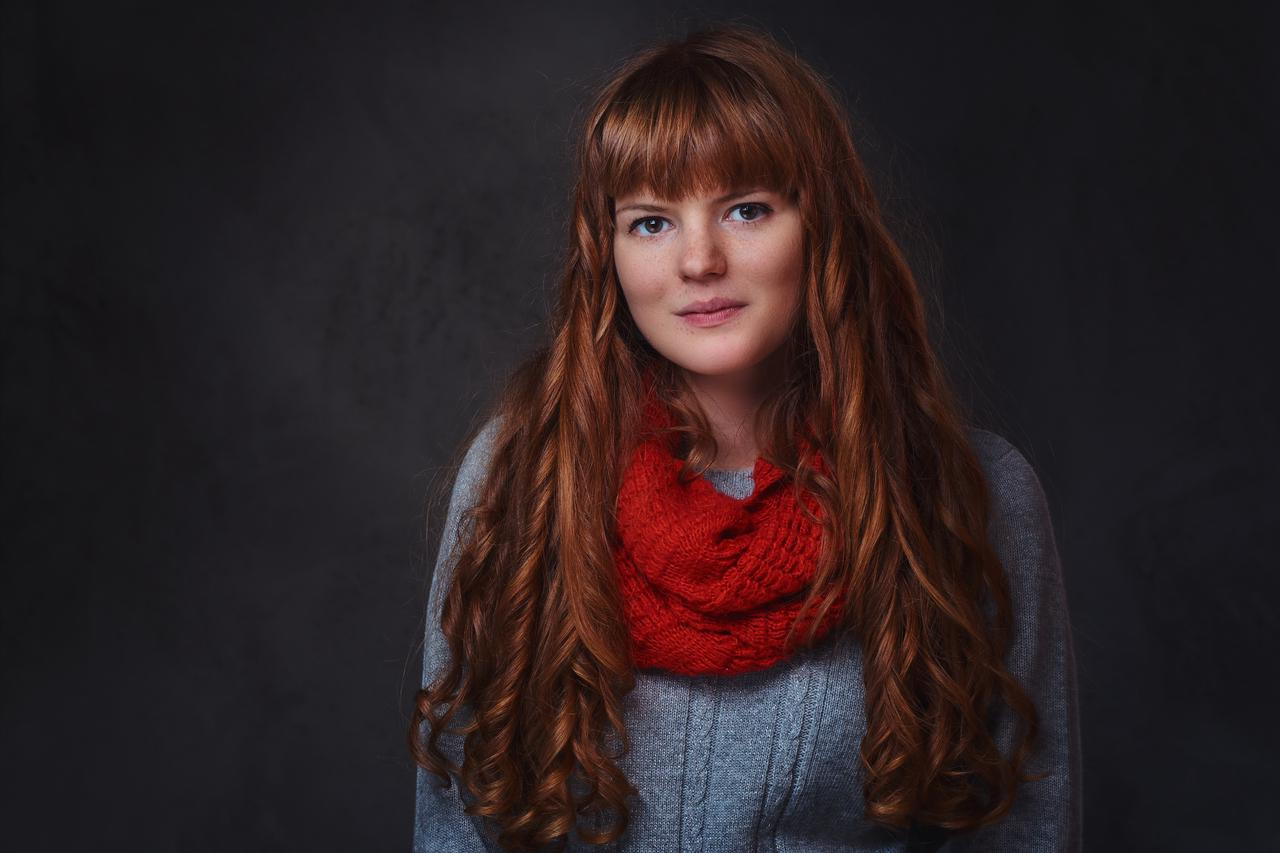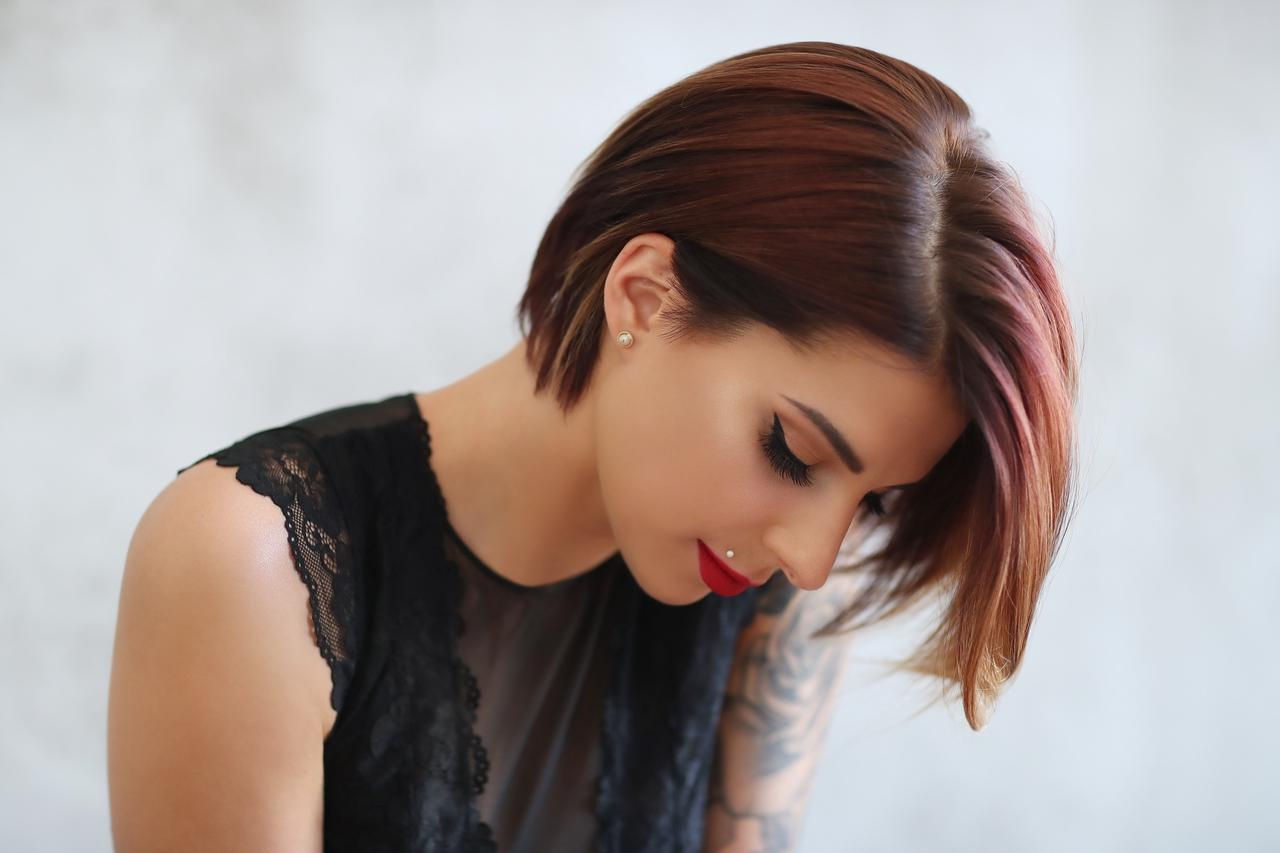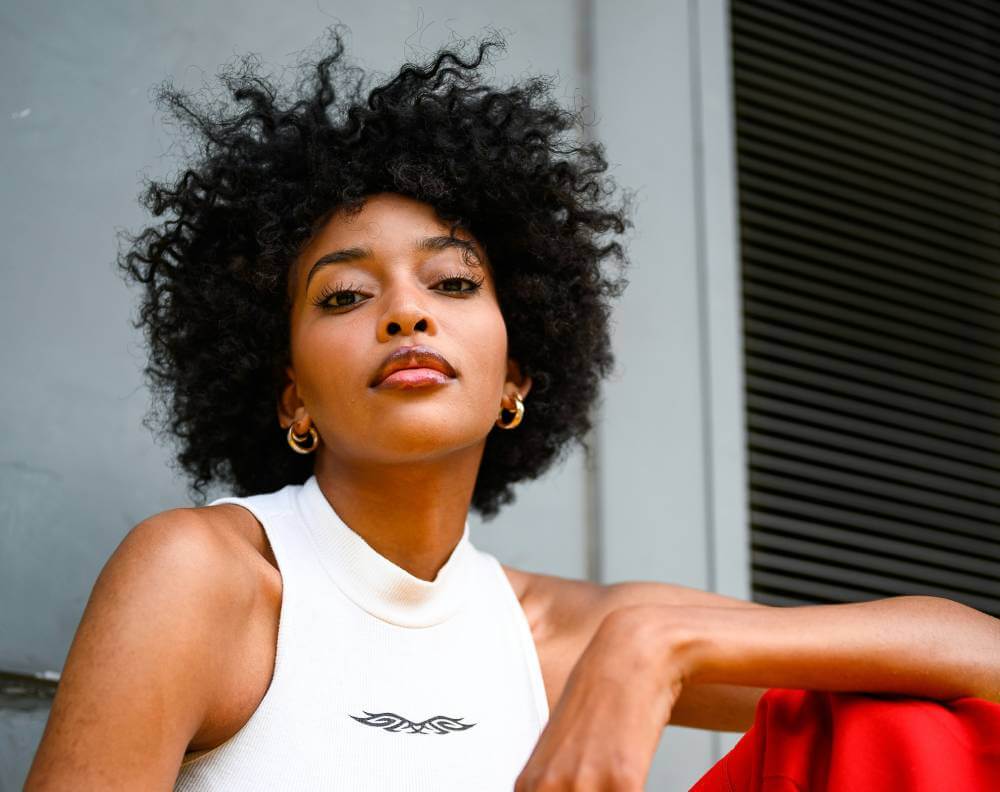The triangle face shape is less common than round, oval, or heart-shaped faces. With a narrow forehead and wider jawline, it’s sometimes called a triangle face or pear face opposite the heart-shaped face.
Don’t worry if you have a triangle face shape and are not limited in styling options. The goal is to work with and enhance what you have. Here’s a guide to help you choose the best hairstyles and styling techniques for your triangle face shape.
Triangle Face Shape Characteristics
If you have a triangle face shape, you may notice the following:
Your face is longer than wide.
Forehead and temple areas are narrower.
Cheekbones are less prominent or flatter.
The jaw is either angular and square like a square face or softer and slightly fleshy like a round face.
The chin is square-shaped.
Since the triangle face shape is bottom-heavy, the key is to balance out a broad jaw. Go for styles that enhance your forehead and avoid adding volume to the sides.
Inverted triangle faces, which are more common and feminine, have a broad forehead and a face that narrows towards the jawline. Hairstyles for inverted triangles aim to balance the hairline and add width to the chin.
Best for Triangle Faces
Want the most flattering hairstyle for your face? Check out these below.
Straight Haircuts

Straight haircuts are great for triangle faces, as they can add volume and balance to the face’s proportions. This style counteracts the bottom-heavy triangle face by adding width where it’s needed and creating a more balanced look.
Why Straight Works?
Straight haircuts give a sleek and clean look that balances triangle face shapes’ broad jawline and narrow forehead. By keeping the hair straight and not too layered, you’re not drawing attention to the wider parts of the face. Straight hair also gives a uniform texture that visually lengthens the face and makes it more balanced.
Best Lengths and Styles
To flatter a triangle face shape, go for straight hair that falls no shorter than eye level. Hair that’s too short will emphasize the jawline and make the forehead even narrower. Medium to long straight styles are great, as they balance out the face’s proportions. Try a classic one-length cut, straight lob (long bob), or long layers that start below the shoulders.
Adding Volume and Texture
If you want to add more to your straight hair, use products that add volume and texture without adding bulk. A light mousse or volumizing spray can create body and movement and prevent the hair from looking flat and lifeless. Using dry shampoo regularly is also good; it can refresh your hair between washes and add extra volume.
Styling Tips
Avoid Heavy Layers: While layers can add movement to straight hair, heavy or choppy layers will emphasize the triangle face shape. If you choose to go this route, go for subtle layering.
Side Parting: A side part can balance by drawing attention away from the jawline and creating the illusion of a wider forehead.
Avoid Excessive Short Cuts: To balance, keep hair lengths at or below eye level. Short cuts emphasize the jawline and make the forehead area look even narrower.
Going for straight haircuts that add volume and balance will flatter your triangle face shape and keep your style fresh and pretty.
Thick Fringe

A thick fringe or bangs is a great styling option for a triangle face shape, especially if your face is rounder and softer. This style will balance your features by adding volume and dimension to the forehead area.
Styling Tips for Thick Fringe
Length and Cut: Go for a fringe that’s cut straight across or slightly curved. This will cover part of your forehead and give the illusion of a more balanced upper face. Make sure the fringe is long enough to achieve the desired effect but not too long that it overwhelms your features.
Volume and Texture: Use a texturizing spray or volumizing mousse to add body to your fringe. This will prevent it from laying flat and keep it looking fresh and lively. Light styling gel or cream will help keep your fringe in shape throughout the day.
Maintenance: Regular trims are a must to keep your thick fringe looking good. As your hair grows, the fringe may lose shape or blend with the rest of your hair. Schedule frequent appointments with your stylist to maintain the perfect length and style.
Complementary Styles: To balance out the look, go for straight or lightly layered hair. This will not draw attention to the sides of your face and will keep the overall style harmonious.
Avoid Over-Product: While a thick fringe can add volume and style, don’t overdo it with too many products. This will result in a heavy or greasy look, which will detract from the youthful and fresh look you’re going for.
Chin-Grazing Layers
Chin-grazing layers are a great option for a triangle face shape. This style will balance out the natural proportions of your face without adding length. Here’s why chin-length layers work and how to style them:
Chin-Grazing Layers
Balanced Proportions: A chin-length haircut will stop at the jawline and won’t make your face look longer. This will create a more balanced silhouette and counteract the bottom-heavy triangle face shape.
Softens Angular Features: By adding layers, especially around the chin area, you can soften the angles of the jawline. The texture and movement will draw attention away from a broad jaw and create a more harmonious overall look.
Versatility: Chin-grazing layers can be styled in many ways, making this haircut versatile for different occasions. Whether you want a sleek and polished look or a more relaxed and tousled style, this haircut will work for you.
Styling Tips for Chin-Grazing Layers
Add Layers for Texture: Ask for layers throughout the chin-length cut to add texture and prevent the hair from laying flat. This will also reduce the emphasis on the jawline and make it less prominent.
Add Volume: Use volumizing mousse or styling spray to add body and volume to your hair. This will create a fuller look and prevent the chin-grazing cut from looking too heavy or flat.
Consider a Bob: A chin-length bob with layers is an excellent option for a light and trendy look. The bob shape works for a triangle face shape, providing structure without adding length. Make sure the bob is well-layered to add texture and movement.
Avoid Heavy Ends: Avoid blunt, heavy ends which will accentuate the width of your jawline. Go for soft tapered layers to create a more balanced and flattering look.
Regular Maintenance: Get regular trims to keep your chin-grazing layers looking fresh. This will maintain the shape and prevent the layers from becoming uneven or losing definition.
Complementary Styling
Straight or Wavy: Chin-grazing layers work with both straight and wavy textures. Straight hair highlights the sleekness of the cut, while soft waves add a relaxed vibe.
Side Part or Middle Part: Try different parts to see what works for your face shape. A side part balances the proportions, while a middle part gives a more symmetrical look.
Soft Jawline Styles
When choosing hairstyles for a triangle face shape, you need to consider if your jawline is soft or angular. Knowing this will help you choose styles that will accentuate your features and create a balanced look. Here’s a guide to styles for soft jawline:
Characteristics
Rounded edges
No angles
Blends into the neck and chin, creating a gentle and less defined outline
Styling Considerations
Hairstyles should add structure and definition while still being in harmony with the softness of the jawline.
Recommended Hairstyles for Soft Jawline
Textured Waves
Textured waves will add volume and dimension to your hair and balance the soft curves of your jawline.
Use sea salt spray or a curling iron to create loose, natural waves. This will add body and movement and draw attention away from the softness of the jawline.
Layered Bob
A layered bob that hits the chin can provide structure and definition without accentuating the softness of the jawline.
Go for soft layers that add texture and movement. A side part will add more balance and a touch of elegance.
Side-Swept Bangs
Side-swept bangs will frame the face and add angles, which will contrast nicely with a soft jawline.
Keep the bangs longer and styled to one side. This will add definition and balance the proportions of your face.
Soft Layers with Volume
Adding volume to the top of your hair will balance out a soft jawline by creating contrast and structure.
Use volumizing mousse or styling cream to lift the roots and create soft layers. This will add dimension and prevent the hair from falling flat against your face.
Face-Framing Layers
Face-framing layers will soften the jawline and create a more balanced look.
Ask your stylist to cut layers that start around your face and blend into the rest of your hair. This will add softness and structure to your overall appearance.
Now that you know your soft jawline, you can choose hairstyles that will accentuate your features and create a balanced look. Try different styles and techniques to see what works for you.
Deep Side Part
The deep side part is great for triangle face shapes. A middle part can accentuate a wide jawline, but a deep side part will balance and complement your face shape. Here’s why and how:
Why a Deep Side Part?
Balance and Proportion: A deep side part will create the illusion of a more balanced face shape by pulling attention away from the wide jawline and towards the top of the face.
Softening Effect: It softens the angles of the face and adds visual interest by breaking up the broadness of the jaw area.
Enhanced Facial Structure: This parting style highlights the natural contours of your face and gives it more definition.
How to Style a Deep Side Part?
Create the Part
Use a comb or your fingers to part the hair.
Start the part just above your eyebrow on one side and go back. The deeper the part, the more dramatic the effect.
Add Volume
Use volumizing mousse or spray on the roots to add lift and body to the hair. This will accentuate the side part and add dimension.
Apply damp hair before blow-drying. Use a round brush to lift the hair at the roots and add volume.
Style the Hair
Blow-dry the hair towards the part to set it in place. Use a styling brush to smooth out any kinks or bumps.
Apply a light-hold hairspray or texturizing spray to keep the part in place and add texture.
For Hair Type
For straight hair, make sure the part is clean and defined. If needed, use a straightening iron to keep the hair smooth.
For curly or wavy hair, leave a natural texture. Define the curls around the part with a curl-enhancing product, but don’t flatten the volume.
Maintenance
Recreate the deep side part daily to keep the style fresh and consistent.
Too much product will damage your hair and make the part less defined. Use just enough to achieve the look.
Hairstyles to Avoid Triangle Face Shapes

Cuts that Draw Attention to Your Chin
When considering hairstyles for a triangle face shape, especially if you have a wide jawline and a narrower forehead, you need to balance and not emphasize the chin. Straight hair can work, but certain cuts, like a bob, may not be the best. Here’s why and what to watch out for:
Why Bobs Aren’t Ideal?
Focus on the Chin: Bobs, especially those that end at or near the chin, will accentuate the chin area, draw more attention to it, and make the face look more bottom-heavy.
No Balance: A straight bob doesn’t balance the forehead and jawline, which is important for a triangle face shape. It will make the chin look even more prominent without adding volume or interest to the top of the head.
Long Hair
Long hair that goes past the chest can be tricky for triangle face shapes. But if you love long hair, make sure there are layers and lots of texture to bring the shape back to your face.
Why is Long Hair a Problem?
Highlights the Jawline: Long, straight hair will draw attention to a wider jawline, which may not balance with a narrower forehead.
No Balance: Without styling, long hair can make the bottom-heavy triangle face look more unbalanced.
Full Bangs
Full bangs that cover the entire forehead and fall straight across can be less flattering for triangle face shapes.
Why Full Bangs Don’t Work?
Highlights the Jawline: Full bangs create a solid horizontal line across the forehead, making your face look more rectangular or boxy. This will accentuate the already prominent jawline of a triangle face and draw attention to the lower part of the face rather than balancing the look.
Hides the Forehead: Covering the entire forehead with bangs will hide the top of your face. A narrower forehead is a characteristic of triangle face shapes, and hiding it with full bangs will make the face look more bottom-heavy. The lack of visibility of the forehead will reduce the overall balance of your facial proportions.
Adds to the Bottom: Full bangs will add volume around the chin and jaw area. Since triangle faces are wider at the jawline, adding more volume here will make it even wider and look unbalanced.





